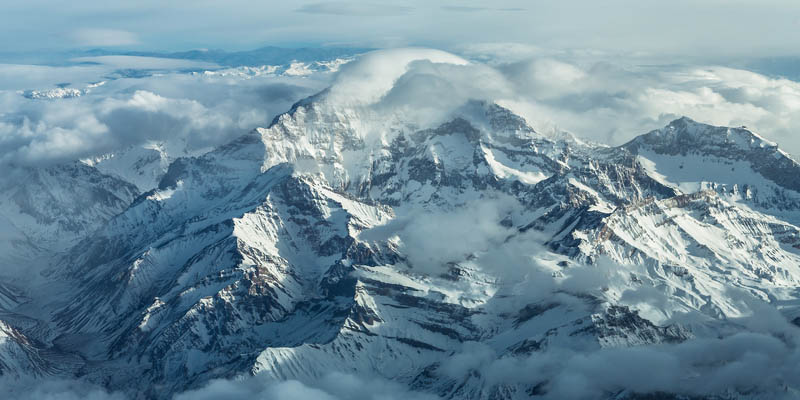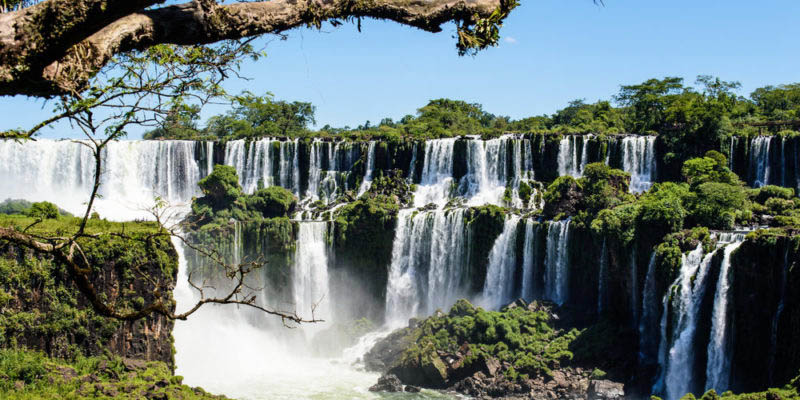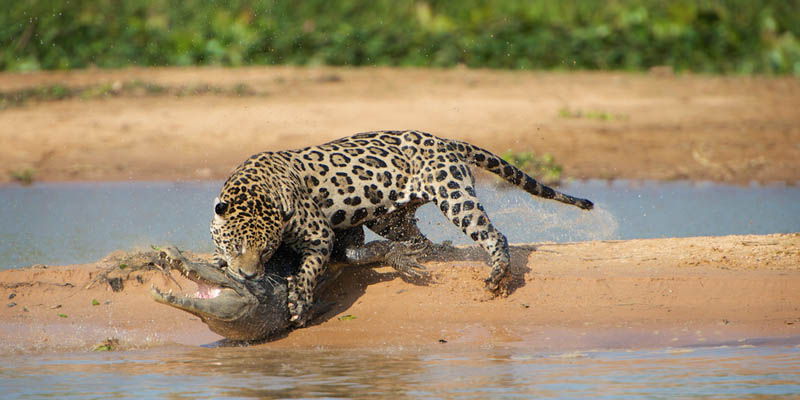Table of Contents
CHARACTERISTICS OF SOUTH AMERICA
Biography
- It is the southernmost portion of the Americas, the second-largest continent on the planet after Asia.
- It exhibits a wide diversity of landscapes and climates due to its vast surface area which stretches north-south.
- The most outstanding natural wonders are: Iguazú Falls (Argentina and Brazil), Torres del Paine (Chile), Atacama Desert (Chile), Apu Vinicunca Mountain (Peru), Hornocal (Jujuy) and Aconcagua (Argentina).
- The prevailing climate in regions near the equator is moist and warm. In regions close to the South Pole, the climate is predominantly cold and dry. In mountainous areas, the climate varies according to altitude.
- The main language is Spanish. Portuguese is spoken only in Brazil, English in Guyana, and Dutch in Suriname. Several indigenous languages like Quechua are preserved.

- Region:
South America
- Area:
6,888,000 sq mi (17,840,000 km2)
- Population:
423,000,000 people.
- Number of countries:
12 (Argentina, Bolivia, Brazil, Chile, Colombia, Ecuador, Guyana, Paraguay, Peru, Suriname, Uruguay, and Venezuela).
We explore South America, and describe its physical and cultural characteristics. In addition, we discuss the economy, religion and history of this region.

What is South America?
South America is the region of the Americas that lies south of Central America. It is surrounded by the Pacific Ocean to the west, and the Atlantic Ocean to the east, and covers an area of about 6.87 million square miles (17.8 million km2). It has a population of 423 million.
The geographic classification of the Americas into three regions (North America, Central America, and South America) results from the structural differences that make up the continent. The shape of the Americas may be viewed as consisting of two large triangular-shaped continental landmasses connected by a narrow and elongated strip of land. The northernmost portion receives the name of North America, the southernmost portion is South America, and the isthmus that joins them is called Central America.
How did it get its name? The name "America" comes from Amerigo Vespucci, a Florentine navigator who was the first to suggest that the whole landmass was an entirely new continent rather than an undiscovered part of Asia, as previously thought by other explorers.
CHARACTERISTICS OF SOUTH AMERICA
- It is the southernmost portion of the Americas, the second-largest continent on the planet after Asia.
- It exhibits a wide diversity of landscapes and climates due to its vast surface area which stretches north-south.
- The most outstanding natural wonders are: Iguazú Falls (Argentina and Brazil), Torres del Paine (Chile), Atacama Desert (Chile), Apu Vinicunca Mountain (Peru), Hornocal (Jujuy) and Aconcagua (Argentina).
- The prevailing climate in regions near the equator is moist and warm. In regions close to the South Pole, the climate is predominantly cold and dry. In mountainous areas, the climate varies according to altitude.
- The main language is Spanish. Portuguese is spoken only in Brazil, English in Guyana, and Dutch in Suriname. Several indigenous languages like Quechua are preserved.
- See also: Latin America
Area, population and countries of South America

South America has an area of 6,873,000 square miles (17,800,000 km2), which accounts for 12% of Earth’s total land area. It is made up of twelve independent countries and French Guiana, a dependent territory of France.
The total population of the continent is about 423 million, representing 5.2% of the world's total. The population density is 59 inhabitants per square mile (23.7 inhabitants per square kilometer). The density is higher in large cities like Buenos Aires, São Paulo, or Rio de Janeiro, and is significantly lower in vast sparsely populated areas of the Amazon or the Argentine Patagonia.
Physical geography and climate of South America

Climate of South America
Due to its great latitudinal extent and multiple reliefs, South America shows highly diverse climates. In areas near the equator, warm and humid equatorial climates predominate while in other areas, subtropical climates can be found. More temperate regions predominate in mid-latitudes, and cold polar climates spread across the southernmost regions. In addition, the presence of the Andes causes broad temperature ranges which vary depending on altitude.
Relief of South America
The physical geography of South America can be classified as follows:
- Mountainous relief. Found in the western part of the region, it is characterized by its high elevation. Earthquakes and volcanic eruptions may occur in mountainous areas. The most important mountain range on the continent is the Andes, running north-south.
- Plateaus. Found in central Brazil, southern Venezuela, and Argentine Patagonia.
- Plains. Located in the eastern part of the region, it is characterized by low elevation and an abundance of rivers and lakes. It is the most predominant relief on the continent and includes vast plains like the Amazon, Orinoco, and Chaco-Pampean plains.
- See also: Physical geography of the Americas
Rivers of South America

In terms of hydrography, the majority of the main rivers in the region are located in the eastern part of the continent. The most important is the Amazon River, with a length of over 4,039 miles (6,500 km), and a watershed of more than 2.7 square miles (7 million km2), making it the largest in the world. It covers a large portion of Brazil and part of Ecuador, Colombia, and Peru.
Other important rivers in South America include the Orinoco in the north of the region, and the Paraná, Iguazú, Paraguay, and Uruguay rivers in the south.
Flora and fauna of South America

South America boasts a great diversity of flora and fauna due to its geographic location and climatic variations that extends from the equator to Antarctica.
Regarding flora, the Amazon rainforest is one of the most biodiverse regions in the world, being home to a great variety of plant species. The Atlantic Forest, which covers most of Brazil’s coastal area, is considered one of the most biodiverse forest regions in the world. In the southern part of the continent, the Patagonian forest harbors coihue, lenga, and ñire trees.
As for fauna, the jaguar is among the most emblematic animals in South America, inhabiting mainly in the tropical rainforests of the Amazon basin. It is the largest feline in the Americas and one of the largest in the world. Likewise, the green anaconda, also found in the Amazon rainforest, is the world’s largest snake.
In more arid regions, the prevailing animals are the llama and the alpaca, mainly found in the Andean areas of South America.
Culture and religion in South America

The most widely spoken languages in South America are Spanish and Portuguese. The latter is spoken only in Brazil, but due to the country’s large population, it has nearly the same number of speakers as Spanish, which is spoken in most countries other than Brazil. French, English, and Dutch are also spoken, but none of these languages reach a million speakers on the continent.
In addition to the European languages, there are over 300 indigenous languages spoken by millions of people of indigenous descent in several countries in South America.
The predominant religion in South America is Christianity, with most of the population Catholic Christian, followed by Protestant Christians, especially in Brazil. Other minority religions in South America include Judaism and Islam.
Economy of South America
South American countries have a wide variety of natural resources. The vast plains in the east favor agriculture and livestock farming, as well as hydrocarbon extraction like oil and natural gas. The mountains in the west allow for mineral exploitation, while extensive forest and jungle areas make forestry activities possible.
Argentina and Brazil are among the three largest soybean producers and exporters in the world; Colombia is among the main coffee producers and exporters, while Venezuela is a major oil producer and exporter.
The secondary sector is very important in the region, especially in Brazil and Argentina. Automotive, textiles, petrochemicals, and food and beverages are among the major industries.
In addition to trade and services, tourism is of great importance for South America. Cities like Rio de Janeiro in Brazil, Buenos Aires in Argentina, and Cusco in Peru receive millions of tourists every year.
Countries in South America
South America is composed of 12 independent countries and the dependent territory of French Guiana, governed by France. The independent countries that make up South America are Argentina, Bolivia, Brazil, Chile, Colombia, Ecuador, Guyana, Paraguay, Peru, Suriname, Uruguay, and Venezuela.
All independent countries in the region are full members of the United Nations (UN). In addition, there are regional blocs formed:
- Mercosur. Made up of Argentina, Brazil, Uruguay, Paraguay, and Venezuela.
- The Andean Community. Comprising Bolivia, Colombia, Ecuador, and Peru.
- The Pacific Alliance. Formed by Chile, Colombia, Peru, and Mexico (part of North America).
History of South America
South America is a continent with a rich history that dates back over 13,000 years, when the first humans arrived in the southern part of the American continent. These early inhabitants settled in various regions, developing diverse cultures and social organizations.
The most prominent pre-Columbian empire in South America was the Inca, which flourished for thousands of years in the Andean area. Other indigenous peoples on the continent include the Mapuche in Chile and Argentina, the Guarani in Paraguay, and the Tupi in Brazil.
The conquest of South America began in the 15th century, when Spanish and Portuguese conquistadors arrived on the continent, establishing colonies, and subjecting the indigenous peoples to slavery and exploitation to extract the region’s natural resources.
The European colonies lasted until the early 19th century, when a process of independence began in most South American countries. Led by figures such as Simón Bolívar and José de San Martín, the countries in the region fought for freedom, attaining independence from Spain and Portugal in the 19th century.
During the 20th century, most South American countries alternated between dictatorial and democratic regimes, though in recent decades democracy has consolidated as the political model in most countries.
Explore next:
Was this information useful to you?
Yes NoThank you for visiting us :)